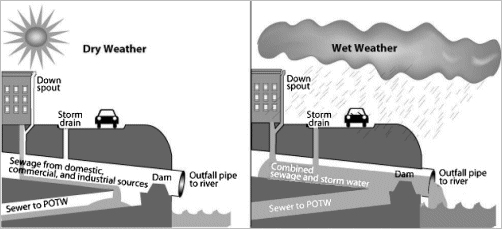Polluted storm water runoff is often transported to Municipal Separate Storm Sewer Systems (MS4s) and discharged into local rivers and streams without treatment. The EPA's Stormwater Phase II Rule establishes an MS4 program to improve the waterways by reducing the pollutants that stormwater picks up and carries into storm sewer systems.
Common pollutants include oil and grease from roadways, pesticides from lawns, sediment from construction sites, and trash such as cigarette butts, paper wrappers, and plastic bottles. These pollutants can impair waterways, discouraging recreational use of the resource, contaminating drinking water supplies, and interfering with wildlife habitats.
In 1990, the EPA promulgated rules establishing Phase I of the National Pollutant Discharge Elimination System (NPDES) stormwater program. The Phase I program requires operators of "medium" and "large" MS4s, who generally serve populations of over 100,000 people, to implement a stormwater management program to control polluted discharges. The Stormwater Phase II Rule extends coverage of the NPDES stormwater program to certain "small" MS4s, but takes a slightly different approach to program development and implementation.
Listed below are documents from the City of Des Plaines' efforts as part of its federal NPDES MS4 Phase II permit. A full explanation of the NPDES MS4 program can be found on the USEPA and IEPA's websites.
Annual Reports:
2023-24 NPDES MS4 Annual Report
2022-23 NPDES MS4 Annual Report
2021-22 NPDES MS4 Annual Report
2020-21 NPDES MS4 Annual Report
2019-20 NPDES MS4 Annual Report
2018-19 NPDES MS4 Annual Report
Additional Documents:
MS4 EPA Notice of Intent 2013
General NPDES Permit ILR40
General NPDES Permit ILR10
Most older cities in the United States were built with combined sewer systems containing a single pipe designed to collect rainwater runoff, domestic sewage and industrial wastewater.
Most of the time, combined sewer systems transport all of their wastewater to a sewage treatment plant where it is treated and then discharged to a body of water. However, during periods of heavy rainfall or snowmelt, the runoff volume can overflow the sewer system or treatment plant and discharge excess wastewater directly to nearby streams, rivers, or other water bodies.
The Tunnel and Reservoir Plan (TARP), sometimes referred to as the "Deep Tunnel," is the long-term plan for the region to reduce and/or eliminate direct discharges of wastewater. The TARP consists of a series of tunnels and reservoirs that temporarily store excess runoff during rain events so that it can be treated before it enters the waterways. In addition, the City of Des Plaines creates separate storm sewers during street reconstruction projects to reduce the volume of rainwater that flows into the combined sewer system.
Example:

Additional Information
A full explanation of the National Pollutant Discharge Elimination System (NPDES) CSO program and information about combined sewer overflows can be found at the United States Environmental Protection Agency’s website.
The Metropolitan Water Reclamation District (MWRD) maintains a network of flow-monitoring devices throughout the Chicago area to detect CSOs. Up-to-date information is available at the Metropolitan Water Reclamation District's website.
Information about the Tunnel and Reservoir Action Plan (TARP) is also available on the Metropolitan Water Reclamation District's website.
View these documents specific to Des Plaines.
